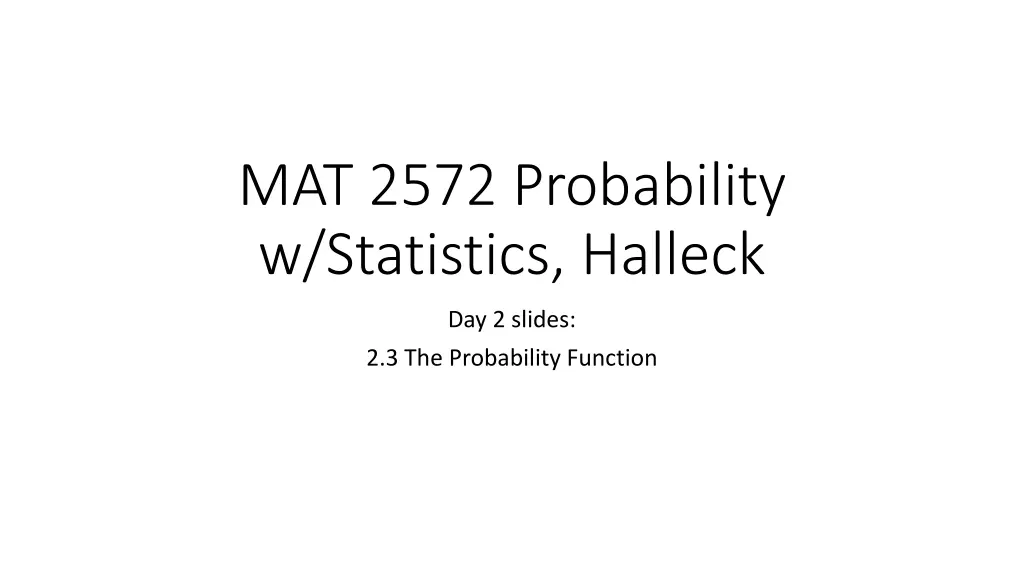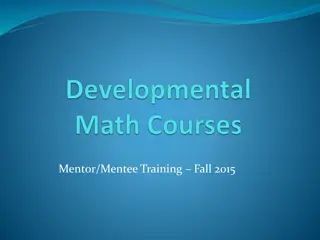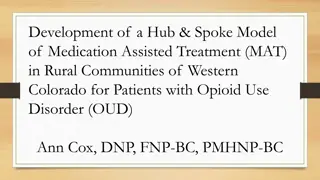
Probability and Statistics: Key Concepts and Theorems for Calculating Probabilities
Explore the fundamental concepts of probability and statistics, including the probability function, mutually exclusive events, DeMorgan's law, and inclusion-exclusion principles. Learn how to apply these theorems to calculate probabilities in various scenarios, such as drawing cards from a deck. Dive into the world of probability and enhance your analytical skills with these foundational principles.
Download Presentation

Please find below an Image/Link to download the presentation.
The content on the website is provided AS IS for your information and personal use only. It may not be sold, licensed, or shared on other websites without obtaining consent from the author. If you encounter any issues during the download, it is possible that the publisher has removed the file from their server.
You are allowed to download the files provided on this website for personal or commercial use, subject to the condition that they are used lawfully. All files are the property of their respective owners.
The content on the website is provided AS IS for your information and personal use only. It may not be sold, licensed, or shared on other websites without obtaining consent from the author.
E N D
Presentation Transcript
MAT 2572 Probability w/Statistics, Halleck Day 2 slides: 2.3 The Probability Function
A function P: events->[0,1] with the following properties is said to be a Probability Function Probability Function 1. P(S)=1 2. If A and B are mutually exclusive, then P(A B) = P(A) + P(B) If we iterate rule 2 an infinite # of times, then it too must be true: 3. If S is infinite, then for {Ai} pairwise mutually exclusive,
Theorems (proofs are in book): 1. P(AC) = 1 P(A) 2. P( ) = 0 3. If A B, then P(A) P(B) 4. P(A B) = P(A) + P(B) P(A B)
Lets focus on the last theorem: P(A B) = P(A) + P(B) P(A B) If we add the cardinality or probability of A to that of B, we will be counting what is in the overlap twice so we subtract it off. This theorem is the first example of a series of statements, called inclusion-exclusion.
Inclusion-exclusion for 3 sets: P(A B C)=P(A)+P(B)+P(C) P(A B) P(A C) P(B C)+P(A B C) Basic idea is the alternation of overcounting and undercounting, i.e., too much is added so items are subtracted, but in the process too much gets subtracted so parts are added back.
Example 2.3.1 (a) Part 4 of the theorem can be rewritten as: P(A B) = P(A) + P(B) P(A B) (b) Use an important theorem from set theory DeMorgan s law: AC BC = (A B)C (c) AC B is just another name for B\A as introduced at the end of day 1.
Example 2.3.2: (on the challenging side) Using part 4 of the theorem
Example 2.3.3 Two cards are drawn from a poker deck without replacement. What is the probability that the second is higher in rank than the first? This is an example where one can use symmetry. Given any card, there are 3 other cards of same rank. Therefore, chance that the 2nd card is of same rank is 3/51=1/17. (Done on day 1 when we calculated chance that if 2 cards are dealt, then they are a pair.) Thus, using complements, chance that they are of different rank is 16/17. By symmetry, there is an 8/17 chance that the 2nd is of higher rank.
Example 2.3.5 (see next 2 slides for VD & table) Biff sends his MCATs to two colleges, X and Y . He estimates that his probability of being accepted at X is 0.7, and at Y is 0.4. He also suspects that there is a 75% chance that at least one of his applications will be rejected. What is the probability that he gets at least one acceptance? Let A = School X accepts him and B = School Y accepts him AC BC represents getting rejected by at least one school Using DeMorgan s law, we know that this is equivalent to (A B)C Hence P(A B), chance of both school s accepting him is 1 .75 = .25 Now use part 4 of the theorem: P(A B) = P(A) + P(B) P(A B) = .7 + .4 .25 = .85
Venn Diagram for Example 2.3.5 A B .45 .25 .15 .15
Table for Example 2.3.5 B\A Y N Y .25 .15 .4 N .45 .15 .6 .7 .3 1






















